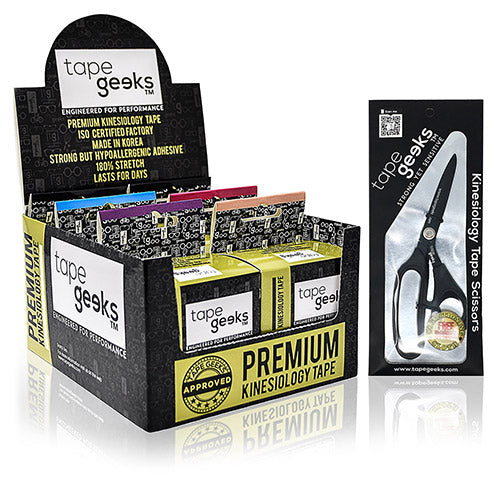
The quad is one of the biggest and strongest muscles in a person's leg. The quadriceps, or quads, are made up of four separate muscles: rectus femoris, vastus lateralis, vastus medialis, and vastus intermedius. These muscles allow a person to stand up, walk, run, and keep the kneecap stable.

Shop our kinesiology tape now
Shop Now
Are you experiencing quad strain?
In this article, read more about its causes, symptoms, available treatments, and how to prevent it in the future. Also, learn how to apply kinesiology tape to the area to give support and relieve the discomfort that you're feeling.
What are the causes of quad strain?

The quadriceps tendon in the quad is commonly strained in people who play sports that require frequent running, jumping, and rapid turns.
You may be more prone to quad strain when:
- Your muscles are fatigued
- Your leg muscles are overstretched
- No warming enough before activity or exercise
What are the symptoms of quad strain?
Quad strain symptoms can include:
- Feeling of pain and swelling in the thigh
- Bruising in the area
- Trouble bending or straightening the knee
- Limited range of motion
- Feeling of weakness in the leg
- Pain when running, kicking, and/or jumping
What are the available treatments for quad strain?

For mild cases of quad strain, home remedies may help the injury heal. However, for more severe cases, you may need to see your health care provider for the best course of action. Treatments for quad strain may include:
- RICE (Rest, Ice, Compression, Elevation).From the first forty-eight to seventy-two hours of the injury, it’s highly advised that the RICE protocol be used. Rest when you feel quad pain when exercising and apply ice or cold pack for 10-15 minutes several times per day.
- Kinesiology tape.Applying kinesiology to the affected area promotes circulation, gives the area support and alleviates some of the swelling and discomfort that you feel.
- Nonsteroidal anti-inflammatory medications.To help reduce the pain and inflammation, your doctor may prescribe over-the-counter pain medication like aspirin, acetaminophen, ibuprofen, and naproxen.
- Surgery.While rare, there are more serious cases where there is a complete tear in the quads. Surgery may be required to address these cases.
How long does it take for a quad strain injury to heal?
Recovering from mild to moderate quad strain may take between one to three weeks given that you limit your activities or exercise. For more severe cases, it may take between four to eight weeks.

Shop our bundles now
Shop Now
How do you apply kinesiology tape for quad strain?
If you’re new to kinesiology tapes, their benefits are worth knowing especially if you’re prone to aches and pains. But the important thing to note is that kinesiology tape helps lift the skin away from the underlying tissues. This will help increase circulation in the area and help alleviate the discomfort you feel.
Before your quads application, here are some tips on how to prepare beforehand. And, since you’ll be applying different kinesiology tape tensions, learn more about it here.
Here is a kinesiology taping protocol that may relieve some of the discomforts that you feel from quad strain:
- Start in a standing position with the heel placed firmly into the ground with weight shifted forward.
- Measure the first security strip from the outside of the quadricep towards the inside of the knees and the second security strip from the inside of the quadricep towards the outside of the knee.
- Round the tape ends.
- Place the first security strip with 0% tension to finish along the inside of the knee.
- Place the second security strip along the inside of the groin forming an X-pattern to finish along the outside of the knee.
- Rub in the tape to activate the adhesive.
Buy Tape Geeks for all your quad strain taping needs

Shop our collection now
Shop NowGive your quads the support it needs without being harsh on your skin with Tape Geeks! made from high-quality adhesives, avoid skin rashes and allergies.
Enjoy a great stick without making your skin sick with Tape Geeks kinesiology tape! TG tapes are hypoallergenic, zinc-free, and latex-free. Moreover, they’re manufactured in an ISO-certified and dermatologist-approved factory in South Korea known for their consistent and reliable adhesives.
Get the best deals for Tape Geeks' products by visiting our Amazon shop today!
How do you prevent quad strain?
To prevent quad strain, make sure that you properly warm your muscles up before doing your exercise routine and lend enough time to cool down after. Additionally, strengthening your quad muscles will make you less prone to quad pain and injuries.
Conclusion
With a little bit of knowledge and the right tools, it is possible to prevent quadriceps strain from happening in the future. Be sure to stretch after any athletic activity or intense workout session, take time off when you need it, and consult with your doctor if you feel that something isn't quite right!
With what you've learned today, why not head over to the Tape Geeks’ blog where we cover other types of injuries? Learn about neck pain as well as scar taping among several others!
Thanks for reading and we hope you found this article helpful!

Shop our accessories and more
Shop Now
Subscribe to the TapeGeeks Newsletter for new videos, discounts and more!Join The Geeks Club









